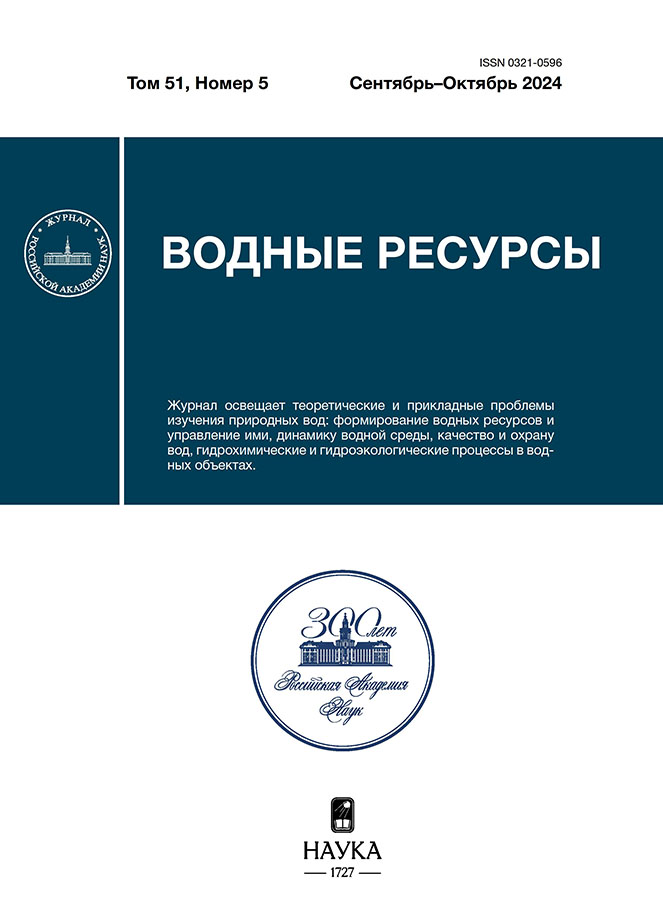Methodological provisions of optimal regulation of the flow of small rivers of the Ural River basin by reservoirs, taking into account ecological and economic criteria
- Authors: Gareev A.M.1, Goryachev V.S.1
-
Affiliations:
- Ufa University of Science and Technology
- Issue: Vol 51, No 5 (2024)
- Pages: 659-665
- Section: Гидроэкологическое состояние бассейна р. Урал и возможность устойчивого управления его водными ресурсами
- URL: https://journal-vniispk.ru/0321-0596/article/view/281540
- DOI: https://doi.org/10.31857/S0321059624050102
- EDN: https://elibrary.ru/VXEAIP
- ID: 281540
Cite item
Abstract
Based on the analysis of the currently existing provisions applied in the management of water use in the river basins of the Russian Federation, taking into account the artificial regulation of river flow by reservoirs, it can be revealed that there are some flaws in them. For example, the guiding documents, including the “Methodological guidelines for the development of standards for permissible impacts on water bodies” the main characteristics of river basins that affect the conditions for the formation of river flow, the ecological and economic characteristics of the location and operation of reservoirs on small rivers, as well as indicators of the formation of additional water losses resources from their surface as a result of evaporation are not fully taken into account. This is primarily related to the basins of small rivers located in arid areas, which include the watercourses of the Ural River basin within its middle and lower parts. Taking into account the above, methodological provisions are proposed that, when designing and constructing reservoirs, provide for the need for a differentiated analysis of the physical and geographical conditions (geographical location, orography, water balance and other characteristics) of the territories where the basins of the studied rivers are located. This is of the greatest importance in the context of the formation of a regional response to global climate warming with the emergence of a set of adverse economic and environmental consequences.
The geosystem approach and the basin principle have been adopted as a methodological basis, which make it possible to comprehensively take into account the peculiarities of the influence of a combination of natural and anthropogenic factors on the formation of variability in quantitative and qualitative characteristics of watercourses and environmental conditions in them. The research methods include: physical and geographical zoning of the Ural River basin within the Russian Federation, statistical and graphical analysis of materials from long-term hydrometeorological observations, analogies, cartography, etc.
As a result of the conducted research, methodological provisions on optimal regulation of the flow of small rivers of the Ural River basin by reservoirs within the Russian Federation, taking into account ecological and economic criteria, are substantiated and proposed. They are part of an extensive list of proposals aimed at the hydrological and ecological restoration of small rivers, taking into account the need for various activities. In particular, the need to determine the optimal number and volume of small ponds and reservoirs in the basins of small rivers, taking into account their normal functioning in low-water conditions and ensuring regulatory water content in the lower links of the hydrographic network along the Ural River basin within the Russian Federation is of leading importance. Accordingly, these methodological provisions have been developed in order to maintain surface and groundwater in a condition that meets the requirements of the water legislation of the Russian Federation.
Keywords
Full Text
About the authors
A. M. Gareev
Ufa University of Science and Technology
Author for correspondence.
Email: aufar.gareev@mail.ru
Russian Federation, Ufa, 450074
V. S. Goryachev
Ufa University of Science and Technology
Email: aufar.gareev@mail.ru
Russian Federation, Ufa, 450074
References
- Влагозапасы и промерзание почв, испарение с почвы и водной поверхности при региональном изменении климата. Рекомендации по расчету и прогнозу средних многолетних изменений. СПб.: ART-XPRESS, 2015. 41 с.
- Водный кодекс Российской Федерации. Новосибирск: Сиб. университет. изд-во, 2010. 48 с.
- Гареев А.М. Оптимизация водоохранных мероприятий в бассейне реки (географо-экологический аспект). СПб.: Гидрометеоиздат, 1995. 190 с.
- Дмитриева В.А. Экологический сток в речных потоках // Регион. системы. 2022. Т. 46. № 3. С. 424–433.
- Дубинина В.Г., Косолапов А.Е., Коронкевич Н.И. и др. Актуализация методических указаний по нормированию допустимого безвозвратного изъятия речного стока и установлению экологического стока для сохранения водных экосистем // Вод. хоз-во России: проблемы, технологии, управление. 2022. № 2. С. 16 – 26.
- Дубинина В.Г., Никитина О.И. и др. Методические подходы к определению объемов допустимого безвозвратного изъятия стока из слабоизученных и малоизученных и малых рек // Вод. хоз-во России. 2015. № 4. С. 80–97.
- Кадильников И.П. Физико-географическое районирование Башкирской АССР. Уфа, 1964. 210 с.
- Методические указания по разработке нормативов допустимого воздействия на водные объекты. М.: МПР России, 2007. № 328. 38 с.
- Постановление Правительства Российской Федерации от 30 декабря 2006 г. № 881 “О порядке утверждения нормативов допустимого воздействия на водные объекты”. Государственный комитет Российской Федерации по рыболовству, Федеральная служба по гидрометеорологии и мониторингу окружающей среды и Федеральная служба по надзору в сфере защиты прав потребителей и благополучия человека.
- Постановление Правительства Российской Федерации от 18 апреля 2014 года о зонах затопления, подтопления. № 360. 7 с. С изменениями 17 августа 2022 г.
- Ресурсы поверхностных вод СССР. Т. 12. Вып. 2. Урало-Эмбинский район. Л.: Гидрометеоиздат, 1970. 512 с.
- Фащевский Б.В. Основы экологической гидрологии. Минск: Экоинвест, 1996. 240 с.
- Федеральный закон “Об охране окружающей среды” от 10 января 2002 г. № 7-ФЗ // Собрание законодательства Российской Федерации. 2002. № 2. Ст. 133; 2004. № 35. Ст. 3607; 2005. № 1. Ст. 25; № 19. Ст. 1752; 2006. № 1. Ст. 10; № 52. Ст. 5498; 2007. № 7. Ст. 834; № 27. Ст. 3213.
Supplementary files











